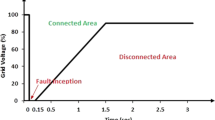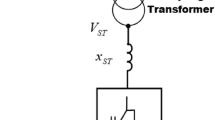Abstract
In this paper, a hybrid method is proposed to damp frequency and power oscillations in the power system equipped with unified power flow controller (UPFC) and power system stabilizer (PSS) controllers. The method is robust with respect to operating point’s changes. This hybrid method consists of two stages: offline and online. In the offline stage, the coefficients of PSS and UPFC controllers for different operating points have been found by PSO algorithm; then in the second stage, online new fuzzy controller is proposed to select the best PSS and UPFC coefficients according to operating point. The proposed method is simulated for single machine infinite bus system-associated PSS and UPFC for three different operating points in MATLAB software, and results of proposed method simulation are investigated and compared with conventional PSS (CPSS) + UPFC, CPSS controllers. Simulation results show that the proposed method has a better performance.













Similar content being viewed by others
References
Kundur P (1994) Power system stability and control. EPRI power system engineering series. Mc Graw-Hill, New York
Anderson PM, Fouad AA (1994) Power system control and stability. IEEE Press, New York
Abd-Elazim SM, Ali ES (2013) A hybrid particle swarm optimization and bacterial foraging for optimal power system stabilizers design. Int J Electr Power Energy Syst 46(1):334–341
Mostafa HE (2012) Design and allocation of power system stabilizers using the particle swarm optimization technique for an interconnected power system. Int J Electr Power Energy Syst 34(1):57–65
Eslami M, Shareef H, Azah M, Khajehzadeh M (2012) An efficient particle swarm optimization technique with chaotic sequence for optimal tuning and placement of PSS in power systems. Int J Electr Power Energy Syst 43:1467–1478
Safari A (2013) A PSO procedure for a coordinated tuning of power system stabilizers for multiple operating conditions. Int J Electr Power Energy Syst 11:665–673
Ragavendiran A, Gnanadass R, Ramakrishnan K (2015) A new SPARLS algorithm for tuning power system stabilizer. Int J Electr Power Energy Syst 68:327–335
Tayal VK, Lather JS (2015) Reduced order H∞ TCSC controller & PSO optimized fuzzy PSS design in mitigating small signal oscillations in a wide range. Int J Electr Power Energy Syst 68:123–131
Peres W, de Oliveira EJ, Passos Filho JA, da Silva Junior IC (2015) Coordinated tuning of power system stabilizers using bio-inspired algorithms. Int J Electr Power Energy Syst 64:419–428
Ellithy K, Said S, Kahlout O (2014) Design of power system stabilizers based on μ-controller for power system stability enhancement. Int J Electr Power Energy Syst 63:933–939
Soliman M, Elshafei AL, Bendary F, Mansour W (2010) Robust decentralized PID based power system stabilizer design using an ILMI approach. Electr Power Syst Res 80:1488–1497
Ramakrishna G, Malik OP (2010) Adaptive PSS using a simple on-line identifier and linear pole-shift controller. Electr Power Syst Res 80:406–416
Sambariya DK, Prasad R (2014) Robust tuning of power system stabilizer for small signal stability enhancement using metaheuristic bat algorithm. Int J Electr Power Energy Syst 61:229–238
Soliman M (2015) Robust non-fragile power system stabilizer. Int J Electr Power Energy Syst 2015(64):626–634
Bhati PS, Gupta R (2013) Robust fuzzy logic power system stabilizer based on evolution and learning. Int J Electr Power Energy Syst 53:357–366
Alkhatib H, Duveau J (2013) Dynamic genetic algorithms for robust design of multimachine power system stabilizers. Int J Electr Power Energy Syst 45:242–251
Nechadi E, Harmas MN, Hamzaoui A, Essounbouli N (2012) A new robust adaptive fuzzy sliding mode power system stabilizer. Int J Electr Power Energy Syst 42:1–7
de Campos VAF, da Cruz JJ, Zanetta LC Jr (2012) Robust and optimal adjustment of power system stabilizers through linear matrix inequalities. Int J Electr Power Energy Syst 42:478–486
Khodabakhshian A, Hemmati R (2012) Robust decentralized multi-machine power system stabilizer design using quantitative feedback theory. Int J Electr Power Energy Syst 41:112–119
Zadeh LA (1965) Fuzzy sets. Inf Control 8:338–353
Ying H (2000) Fuzzy control and modeling: analytical foundation and applications. IEEE Press, New York
Sharma D (2011) Designing and modeling fuzzy control systems. Int J Comput Appl 16:1
Wang LX (1997) A course in fuzzy systems and control. Prentice Hall PTR, Upper Saddle River
Driankov D, Hellendoorn H, Reinfrank M (1993) An introduction to fuzzy control. Springer, New York
Hingorani NG, Gyugyi L (2000) Understanding FACTS. IEEE Press, New York
Simfukwe DD, Pal BC, Jabr RA, Martins N (2012) Robust and low-order design of flexible ac transmission systems and power system stabilisers for oscillation damping. Inst Eng Technol 6:445–452
Eslami M, Shareef H, Mohd RT, Khajehzadeh M (2014) Adaptive particle swarm optimization for simultaneous design of UPFC damping controllers. Int J Electr Power Energy Syst 57:116–128
Hashemi A, Tabatabaei NM, Taheri N, Naderi S (2012) A flexible neural controller for transmission systems equipped with UPFC. Int J Tech Phys Probl Eng (IJTPE) 4(3):167–176
Sedighizadeh M, Minooie B, Sarvi M (2013) Power system stability enhancement using a NSPSO designed UPFC damping controller. Int J Tech Phys Probl Eng 5(4):1–8
Hassan L, Moghavvemi M, Almurib HF (2012) Modeling UPFC into multi-machine power systems. Arabian J Sci Eng 37(6):1613–1624
Shayeghi H, Safari A (2009) Simultaneous coordinated designing of UPFC and PSS output feedback controllers using PSO. J Electr Eng 60(4):177–184
Tambey N, Kothari ML (2003) Damping of power system oscillations with unified power flow controller. IEE Proc Gener Transm Distrib 150(2):129–140
Kennedy J, Eberhart R (1995) Particle swarm optimization. Proc IEEE Intl Conf Neural Netw 4:1942–1948
Poli R, Kennedy J, Blackwell T (2007) Particle swarm optimization an overview. Int J Swarm Intell 1:33–57
Shivakumar R, Lakshmipathi R (2010) Power system stability enhancement using bio inspired genetic and PSO algorithm implementation. Int Rev Electr Eng (IREE) 5(4):1609–1615
Shaheen HI, Rashed GI, Cheng SJ (2010) Application and comparison of computational intelligence techniques for optimal location and parameter setting of UPFC. Eng Appl Artif Intell 23(2):203–216
Abido MA (2001) Particle swarm optimization for multimachine power system stabilizer design. IEEE Power Eng Soc Summer Meet 3:1346–1351
Wang LX (1997) A course in fuzzy systems and control. Prentice Hall PTR, Upper Saddle River
Driankov D, Hellendoorn H, Reinfrank M (1993) An introduction to fuzzy control. Springer, New York
Rezvani A, Gandomkar M (2016) Modeling and control of grid connected intelligent hybrid photovoltaic system using new hybrid fuzzy-neural method. Sol Energy 127:1–18
Rezvani A, Khalili A, Mazareie A, Gandomkar M (2016) Modeling, control, and simulation of grid connected intelligent hybrid battery/photovoltaic system using new hybrid fuzzy-neural method. ISA Trans. doi:10.1016/j.isatra.2016.02.013
Rezvani A, Gandomkar M (2016) Simulation and control of intelligent photovoltaic system using new hybrid fuzzy-neural method. Neural Comput Appl. doi:10.1007/s00521-016-2210-2
Uyar O, Çunkaş M (2013) Fuzzy logic-based induction motor protection system. Neural Comput Appl 23(1):31–40
Hamza MF, Yap HJ, Choudhury IA (2015) Recent advances on the use of meta-heuristic optimization algorithms to optimize the type-2 fuzzy logic systems in intelligent control. Neural Comput Appl. doi:10.1007/s00521-015-2111-9
Author information
Authors and Affiliations
Corresponding author
Appendix
Rights and permissions
About this article
Cite this article
Khaksar, M., Rezvani, A. & Moradi, M.H. Simulation of novel hybrid method to improve dynamic responses with PSS and UPFC by fuzzy logic controller. Neural Comput & Applic 29, 837–853 (2018). https://doi.org/10.1007/s00521-016-2487-1
Received:
Accepted:
Published:
Issue Date:
DOI: https://doi.org/10.1007/s00521-016-2487-1




